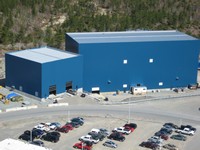
Using best practices, maximizing efficiencies and taking advantage of existing materials is the concept behind the hydraulic fill plant at Xstrata’s Nickel Rim South Mine in Sudbury.
Described as an “on-demand” operation, this fully automated plant will run one-third of the time, as required, to fill stopes. However, when it runs, the process will be a continuous pour, which provides greater homogeneity of the fill.
The company’s past attempts at running similar plants were unsuccessful due either to a lack of availability of people to run the fill system or, as in the case of the Fraser Mine, lack of capacity to pump the water out faster than it was coming in.
“Our objective here is that the pour will go continuously from beginning to end,” said John McCall, area lead for the project. “The plant is highly automated to minimize operator intervention.”
At the same time, Xstrata has installed a dewatering system that has the capacity to keep up with the hydraulic fill during a continuous pour. At its maximum, the system can pump out 500 U.S. gallons per minute.
McCall said the objective is to supply hydraulic fill when required and to do it continuously. Therefore, having enough fill available when the pour is initiated is crucial.
“That is where storage is important,” he said. “We have installed a significant amount of slurry inventory to create a buffer between the trucking, which is a batch process, and the pouring, which is a continuous process.”
A 15,000-tonne storage building at the smelter will be used to ensure there is enough fill for an on-demand pour.
Xstrata Nickel will be using the coarse portion from the low sulphur tailings (clean stream) and backhauling it from the mill.
“Even though it is a long haul (85 km), it is the most economical choice because the backhaul are empty trucks anyway,” McCall said. “We’re doing $13 million worth of work at Strathcona Mill to upgrade that product. We’re putting in a horizontal pan filter to give it an engineered, better quality product for hydraulic fill here.”
Previously, the company dumped the tailings in pits, let it drain and then dug it back up again. It was an environmentally problematic process with little quality control. Once mill upgrades are completed, the process to treat the fill will be better controlled and produce a more reliable product.
“We’ve also built in appropriate redundancy into the plant,” McCall said. “For every pump, there is a standby pump; for the front end of the system where we have a truck receiving, we have two truck- receiving systems.”
This back-up system ensures a continuous pour as well as the ability to blend two different materials: processed tailings from the Strathcona Mill and one million tonnes of legacy tailings from the nearby Nickel Rim North site, a former mine that operated in the ‘50s. This win-win situation provides blended fill for the stopes at Nickel Rim South and cleans up the company’s historic liability.


